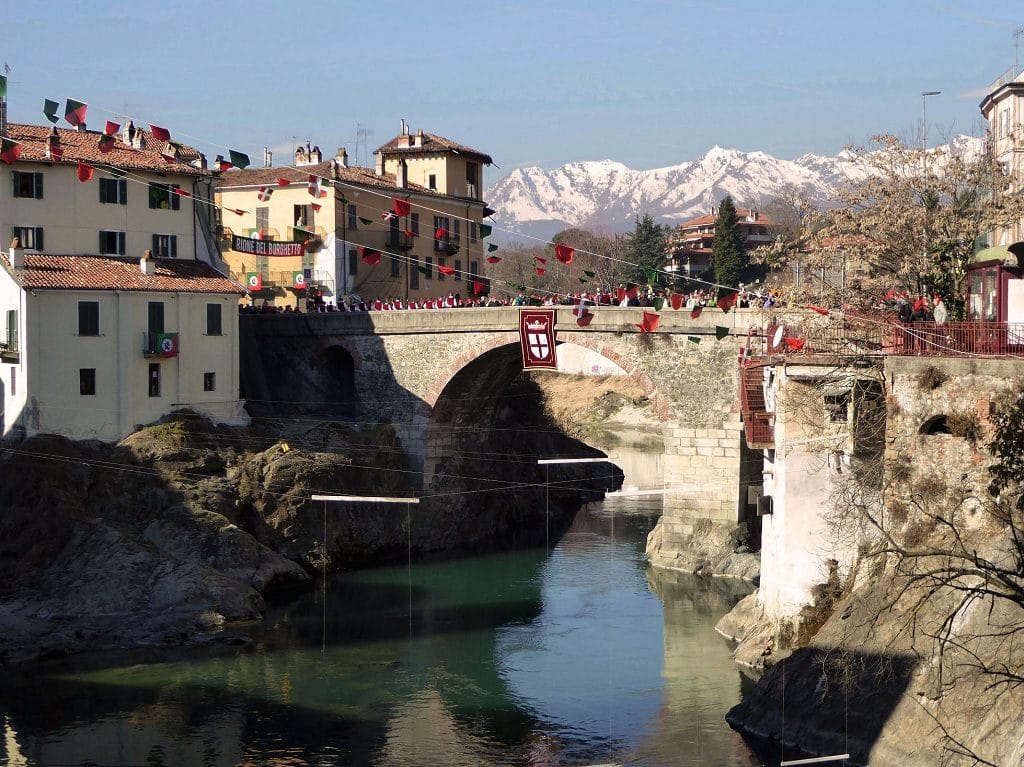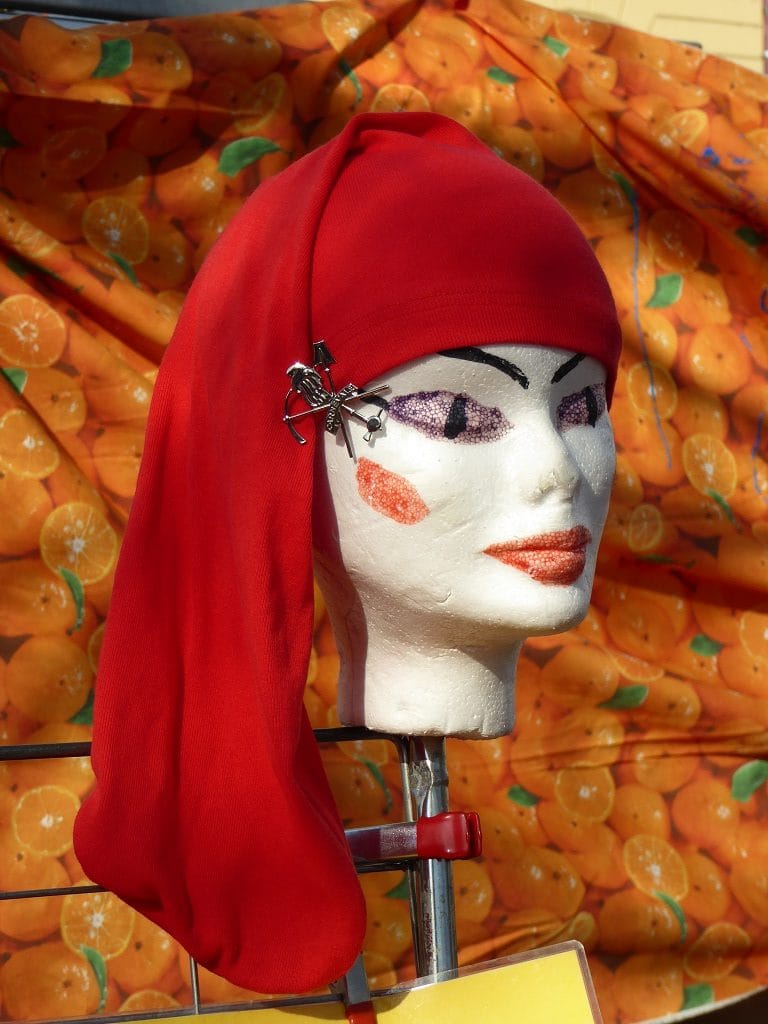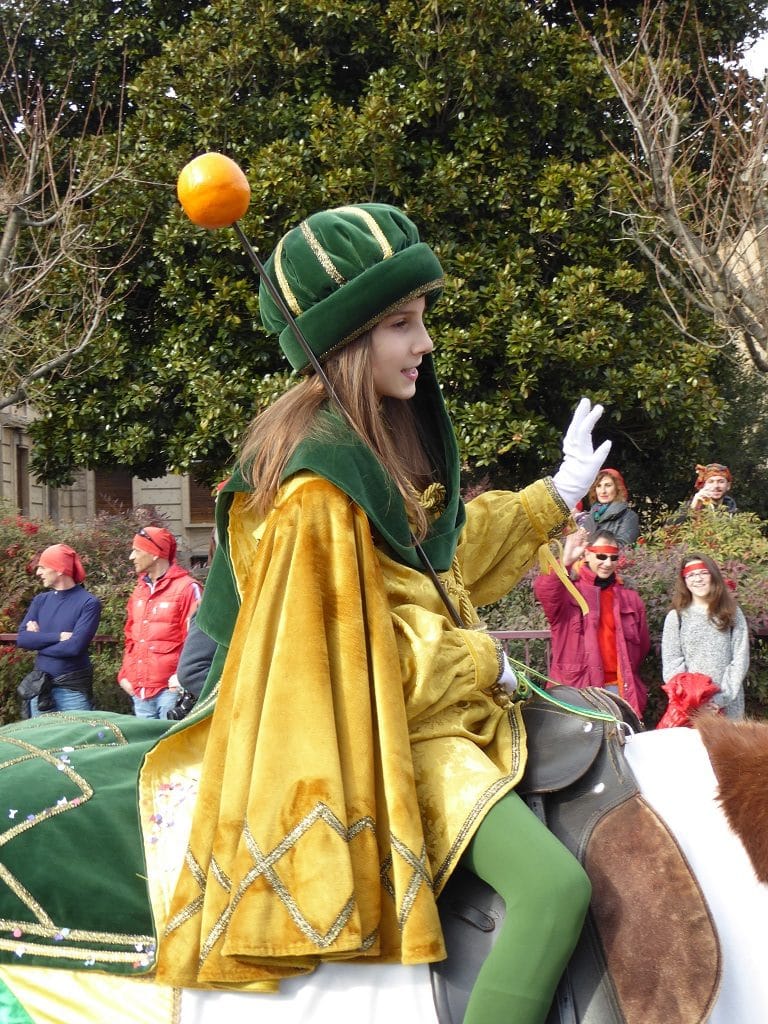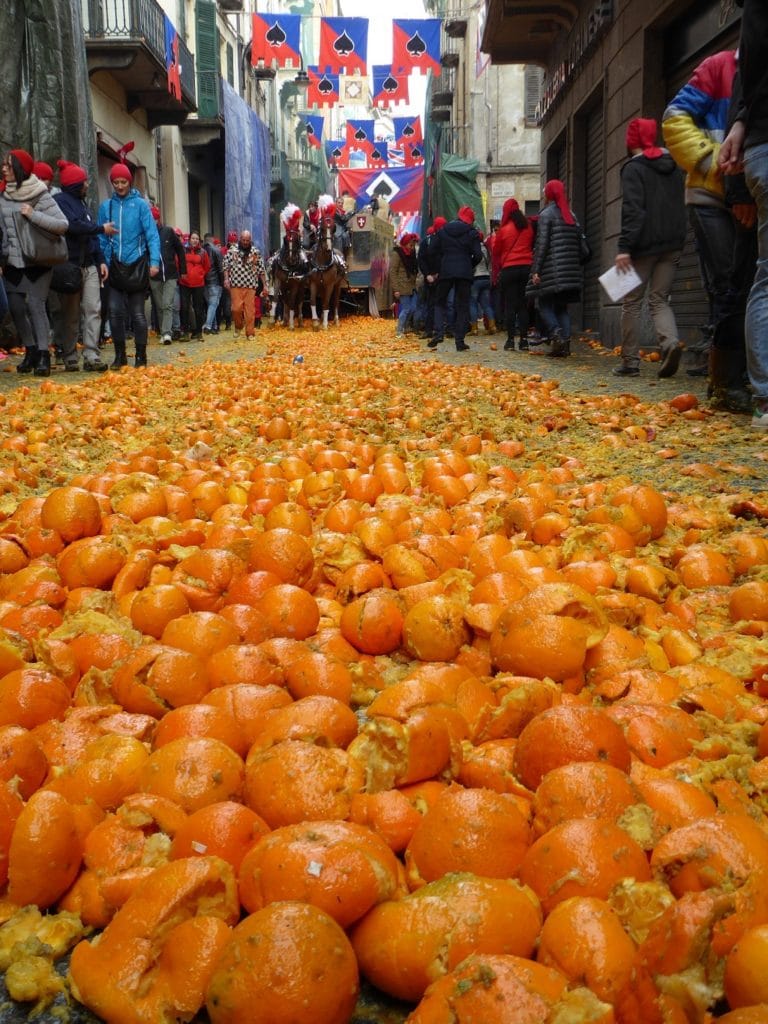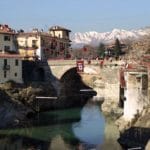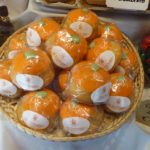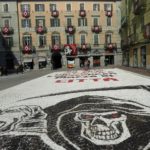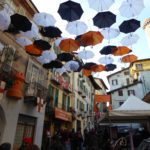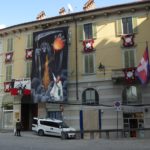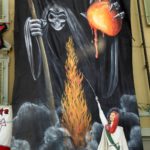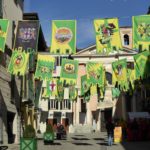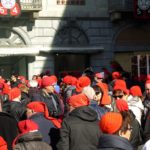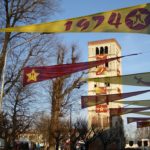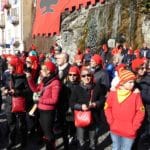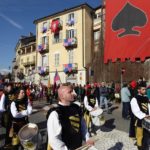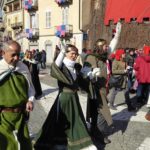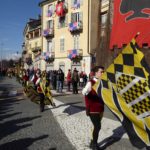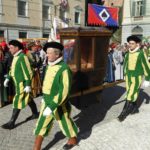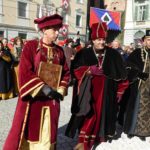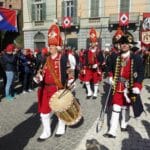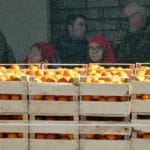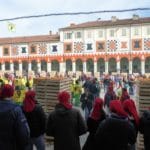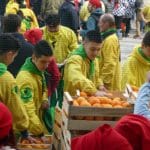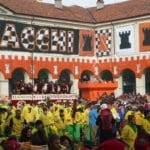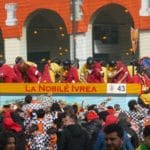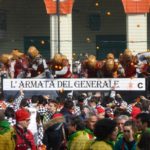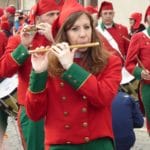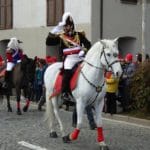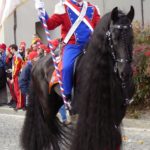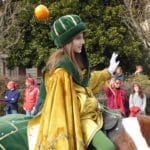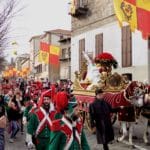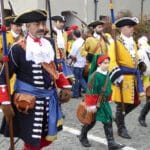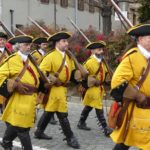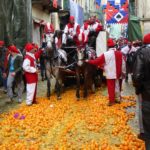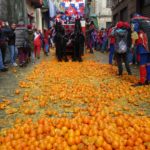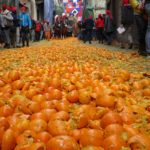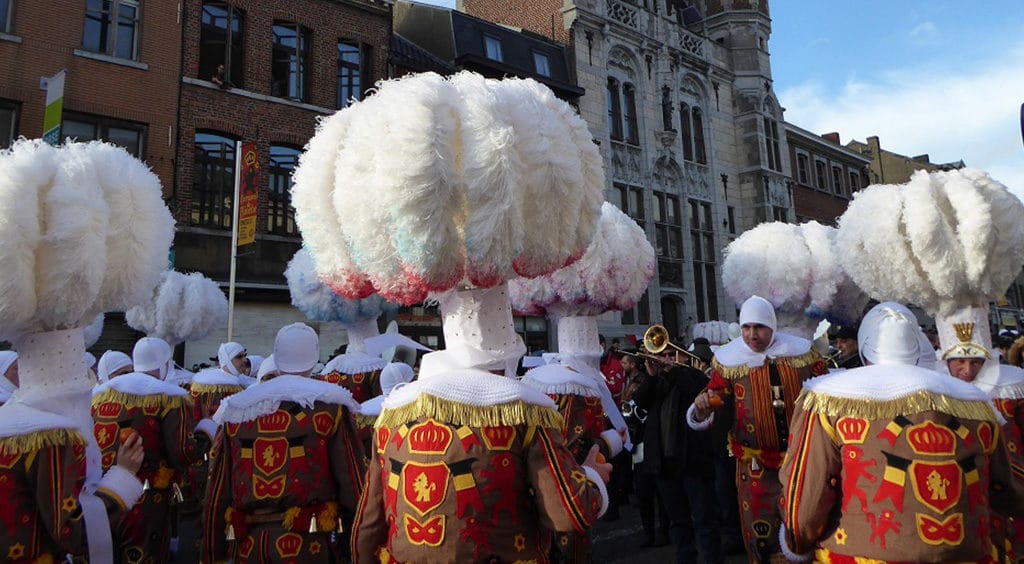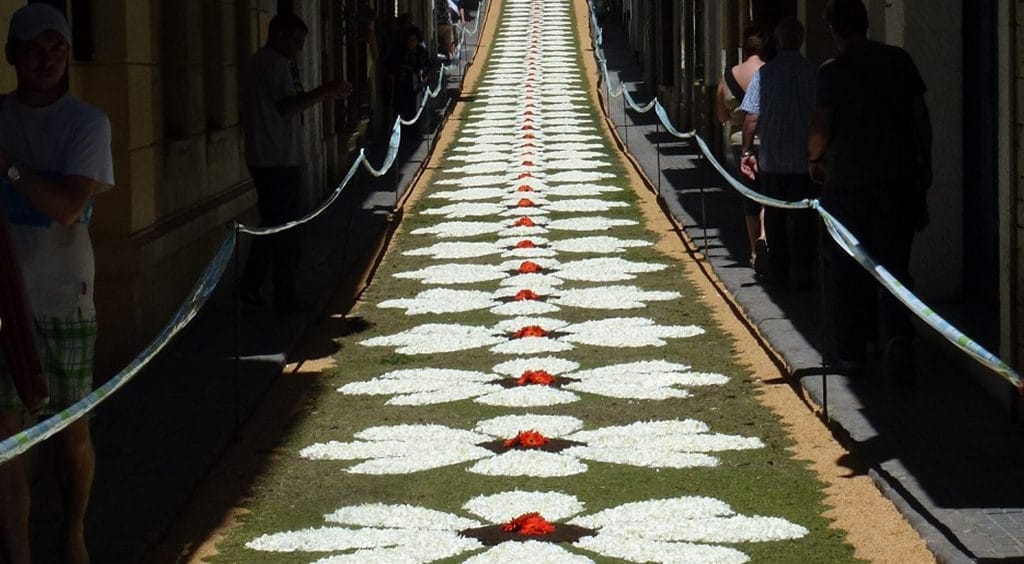The Carnival of Ivrea and the Battle of the Oranges (Carnevale di Ivrea e Battaglia delle arance)
To avoid getting a citrus between my eyes, I put on a mandatory red cap in which I looked like a Smurf. Can you imagine the whole city had the same headpiece?
Once upon a time, around 1200, a marquis lived in Ivrea and tyrannized the city. People hated him. They had to work for him, pay him the taxes, although they were starving themselves, and then he even introduced the ,,right of the first night” and ravished his newlywed vassals.
Yet one day, Violetta, the miller's daughter, came to the castle. She was beautiful and brave. The girl refused to meet the tyrant's demand, instead she got him drunk and cut off his head. This was the beginning of the popular uprising against the rich, ending with the destruction of the marquis's estate. They have never built it up again, and the city has remained free.
However, there is still one reminiscence of the past. Once a year, the lords used to make a "grand gesture" and give the poor a basket of beans. Most of them threw the legumes out of the window, even though their stomachs growled. They repeated this rebellious gesture during the carnival as a mockery to the rich. One day, somehow for fun they began to hurl the beans at each other. In the next years, gradually they switched them for confetti, lupines, flowers, and finally for oranges. Actually, in the middle of the nineteenth century girls at the balconies started to throw them to the carnival parade, to the guys they liked. At that time, the orange was an exotic fruit from the French Riviera, and to be hit with it by some beauty was a kind of honor.
Later, the men began to toss the citruses back and the flirtatious game turned into a fight. In 1854, the throwing was officially banned, but no one respected it, on the contrary, a real fight between the balconies and the street started.
Apparently, the inhabitants of Ivrea love to throw and nobody could take their habit from them. After the Second World War, they established the first team of orange throwers (aranceri) and defined the rules of battle respected until nowadays.
There are nine teams, those pedestrians (representing commoners who revolted) struggle with the feudal army (impersonated by the throwers on horse drawn carriages, protected by masks and leather gear reminding medieval armor). There are about 50 cars, with 5000 people participating. Everybody can join in; even battles for children take place.
The carnival of Ivrea is not just a spectacular orange fight. It lasts almost two months. It begins in January, when the General, who takes power in the city and leads the whole event, is introduced. After that, together with other historical figures, they go to the Chapel of the Three Kings to light candles.
Two Sundays before the main program, other ceremonies take place. According to the strict scenario there are day and night parades for grown-ups or children, presentation of miller's daughter Violetta and her cortège from the municipal ́s balcony, Pich and Pala Trophy in the longest orange throw, the charity cooking and the distribution of bean soup (so-called fagiolata), exhibitions, concerts, parade of carriages, fireworks over the river Dora... There are plenty of activities; the battle of the oranges is fought only for the last three days, from Shrove Sunday to Shrove Tuesday.
When I got off the train in Ivrea, a small town in northwestern Italy, I was welcomed by the beautiful blue sky. In the distance, I saw the menacing sharp shapes of the mountains; and a river around a city was full of kayakers. I had a cappuccino to warm up and a typical El Portugal cake - in the form of an orange, of course, filled with delicious cream. Then I set off to the downtown.
Right next to the station, the vendors of red caps waited for us. This headpiece is very important for citizens but also visitors! The Berretto Frigio, Phrygian cap, symbolizes freedom, revolution and the republic. It was one of the symbols of Mithra, the Persian god of light and sun. In ancient Rome, the master used to give a cap symbolically to slaves upon manumission, in that period it probably became a symbol of liberty.
In Ivrea, you have to wear it at all times for two reasons: because it will protect you from getting oranges directly at your think-box but also as a sign that you actively participate in a carnival, you are one of the revolutionaries. (However, the spectators are not allowed to throw oranges).
It looks like a stocking that Saint Nicholas fills with candy. Put it on in a way that longer part would dangle around your ear, twist it a little and pin with a silver brooch with the Pich e Pala symbols (a pick and a shovel for the Burning of the Poles, explanation later), orange impaled on a sword and a cap, all together tied with a ribbon.
Protesting was out of the question, I bought a berretto and a brooch. It was quite funny, when I installed the "stocking" on my head; I looked like a Smurf or one of the Snow White dwarves :)
The streets and houses were decorated with colors and mottos of their teams. It was immediately clear to me what the fight would look like. Here I saw the skulls with the slogan "Death," there the flags with "Break down the hell!" By the way, guess what kind of sculpture they have at the riverside? The Hand with orange, what else.
The preparations for Sunday were in full swing, local stores offered bracelets, earrings and pendants with orange fruits and complete clothing of the teams. On many walls, I could read the General order to fight.
I had lunch in a restaurant whose floor was covered with bubble wrap; when somebody walked on it; it was popping like rain drops (it's easier to throw out the paper than to wash the floor, full of fruit pulp). For dessert, I had typical carnival goodies - bugie, "lies", the sweet pastry fritters, soaked in chocolate. Yummy!
To get people into a mood, the musicians visited the restaurants and bars and as a reward for playing, they got a drink. In the evening, they moved to their districts, the teams set tables on the streets and enjoyed together the "last supper". The air was silent before the storm...
On Sunday, Ivrea expected twenty thousand visitors, most of them arriving by train from Turin. After night snowing, the mountains looked like besprinkled with sugar and contributed to a festive atmosphere.
The entrance to the city cost eight euros, behind the gate vendors waited again - and this time really everyone bought a headpiece.
Half of a berretto jiggled around my ear, I felt like Pippi Longstocking :) Can you imagine that all the people on the street had the same hat? It was like a meeting of a strange sect. Ivrea was full of dwarves with red caps. I didn’t see any mask, this is not Venice.
In the morning, the Preda in Dora ceremony (A Booty to Dora) took place at the Old Bridge. The Mayor in the long velvet cape reminded the medieval revolt by symbolically throwing to the river a stone from the hated palace and urged citizens to always rebel against tyranny.
Then he went around the city with his entourage: General in the Napoleonic uniform, followed by his officers and the charming vivandieras in the red-blue uniforms (girls who took care about food and drink in the casern). The master of ceremonies in a white wig and a three-pointed hat, representing the notaries, carried the Protocol - the book where, according to tradition, all the ceremonies since 1808 have been described with all the details. Other historical characters were the Assistant Grand Chancellor, the Magnifico Podestà (guarantor of the citizens’ freedom) and the ensigns bearing the flags of the five districts. Then the blowpipe players and drummers walked; knights, court ladies, visiting French musketeers, sending us air kisses, folk groups, soldiers and little Abbà - these are the children in medieval clothes carrying an orange impaled on a sword, symbolizing the beheaded tyrant.
The battle was to start at 2 pm, but the selected squares, lined with the huge stacks of crates of dazzling fruits, began to fill already at 1 pm. I found a good position behind the metal net, put up to protect spectators and buildings, although I had some doubts about its efficiency.
In the meantime, the warriors were warming up. Every team had its own colors. In front of me, on one side there were green-yellow Scorpions and on the other side white-black-orange Chess preparing to fight. Men, women, children. They wore jackets and trousers, scarf around the neck and a two-colored bag across the body. Many added to their outfit something personal, like striped socks or colored hair, one guy had a shaved and painted scorpion on his head.
As the hour-hand approached 2 pm, the warriors began to fill their bags with ,,ammunition”. One man opened the zip of his parka and dropped a few kilos underneath. Then he could only walk slowly and looked like pregnant with triplets.
Suddenly, the silence was broken by the clatter of horse hooves and the first beautifully painted carriage appeared on the square. There were twelve scary aranceri standing on it. Under the t-shirts, they had protective shoulder pads like the American football players; they were huge, angular like a wardrobe. They had leather hoods and faces covered by a crosshatch; the higher part also by a plastic - because the best hit is when the enemy gets a juice in the eyes.
The fight started. The squads on foot attacked, the oranges were beating bang, bang, bang, like rain. Neither the adversaries hesitated. Everything was happening very quickly, I perceived a car as one organism that slung fruits like a machine; it was flying as if everybody had ten hands. Perhaps it is good for relaxing and relieving stress :).
The air filled with a strong smell of citrus. Horses must be under sedatives otherwise they would get crazy! The carriage was bombarded by the Scorpions and the Chess, the fruits flew everywhere around them. Sometimes they missed a target and unexpectedly changed a trajectory, they hit the net - fortunately, it held them down. The Japanese, spattered by a pulp, were thankful for an experience and laughed like children.
The car got around the square, stopping four times, so there was also a space for personal fights. It is all in the sporty spirit, the aranceri follow the unwritten rules of fair play. The better the rivals know each other, the tougher the individual duel is, tossing hardly means to show mutual respect. Finally, they shake hands as a sign of friendship.
The first "hoods" had not yet left the battlefield, and the second carriage arrived. Then they alternated quickly, one after another one, orange balls were flying in the air and the pavement was covered with flesh... There is a special commission who observes the fight in order to decide which team fought the most courageously and technically (but don’t ask me what that means). The cars would pass through all the squares, it may take four hours, locals told me.
Meanwhile, the historical parade started. I wanted to see it, so I began to move slowly from the protected zone. The streets outside, not sheltered by a net, were dangerous to life. Not that aranceri toss to spectators, we had dwarf caps - but a long and considerably violent throw could reach also there. When something headed to us, we screamed and bobbed down, covering our heads. Luckily, I only got one in my arm. Every year there are dozens of injured and treated, and I don’t even mention some monocles under the eye.
The procession went along the river and then into the center; and as it passed through the squares, the fighting stopped. At the head, the General proudly greeted crowds with a gentle gesture like the British Queen. His officers on the magnificent horses followed, the animals were combed and decorated with ribbons and bells. One mare had a dense, shiny floor length hair. (Well, maybe it wasn’t a mare, but a stallion, but it had such a beautiful "hair", I can’t talk about her in a male). Ivrea is famous for the San Savino horse fair, which has been taking place here for several centuries, and obviously, this was an occasion to show the best animals they had breeded.
Then again, many of the historical figures walked; folkloristic and musical groups not only from Italy; and finally the main heroine, Vezzosa Mugnaia - the Graceful Miller (such is her official title), welcomed with a storm of applause and screams of "Evviva!" (Long life!). Each year, a young married girl is chosen to play the part of Violetta, miller’s daughter who started the revolt against the city's tyrant. She wore a white dress as a symbol of fidelity and purity, an ermine cape over her shoulders and a green sash with a red cockade, draping from one shoulder to the opposing hip and of course, a red cap like we all.
She sat in a golden chariot pulled by three white horses, waved to the people and together with her escort of honour threw sweets and mimosas to the crowd.
The parade passed through the city, and when it arrived at the main square Piazza di Città, the battle might have ended ... but later I found out that in some places the aranceri carried on fighting.
When the cars left the battlefield, in the middle of the street they opened the "lower door" and dumped the remaining fruit. The pavement densely covered with orange fruits got slippery, it was like wading through wet snow. Luckily, I took my old boots for this occasion.
People were wallowing in it and making selfies. The air was pleasantly filled with vivid fresh citrus scent.
Each year, there is a polemic about the food waste, because approximately six hundreds of tons of "ammunition" are used in the battle. However, these are not tasty, edible oranges, but the special ones imported from Calabria. In addition, in the evening, the cleaning service would pick them up, put them in prepared barrels and let them ripe; the compost will later be used as a fertilizer.
Several personal duels were still proceeding in the streets. A guy on the car was provoked by an enemy from the ground, they started a close fight for dear life; fair play, man against man. Like when a knight throws down the gauntlet. Armored guard shot fast as a machine gun, precisely like a robot, I was afraid he would beat his challenger to death with orange balls! We, the audience, had to watch them carefully to avoid getting something between eyes. Unexpectedly, we found ourselves in the epicenter of the fight; the oranges in the narrow space bounced back and changed the course, flying in an unpredictable way, and very far away from the throwers. Eventually, the rivals shook their hands, the one on the ground was obviously satisfied with the struggle; leaving as a loser, but smiling. The one on the carriage put off his hood and complained it was too old, he involuntarily drank some juice…
The main square felt like covered with soft carpet; I trudged through a crushed mash. Tired aranceri sat on empty boxes, wiping their faces of pieces of fruit, and relived over and over the fight, recalling how they got hit and how they managed to strike a masked man‘ crosshatch with such force that the orange splattered up. Oranges floated even in the river...
The carnival ends on the night of Shrove Tuesday by the symbolic burning of five wooden poles, wrapped in erica and juniper. On Monday, in every district a couple, married as the last one in the previous year, decided about their placement. During the Zappata ceremony (Digging-in), the wife with shovel and the husband with a pick began to dig in where the poles would be planted.
On Tuesday, the procession goes around all the squares; little Abbá is waiting on each of them with a torch that will set a stake on fire. If a flame is immediately expanding up to the flag, it is considered a good sign; the big bonfire is a symbol of vitality and fertility.
The finale takes place at the square Piazza di Città. When the pole bursts into flames, the Graceful Miller stands up holding a hand with sword raising upward and waits for the fire to burn down the tricolor on the top. Then she distributes around all the red carnations of the bouquet, which decorated her golden chariot...
The General and the others will dismount from the horses and the parade will pass through the center for the last time. It is a strange procession, the crowd is silent, the musicians play the sad melodies. When they arrive at Ottinetti Square, they will play once more the General’s March as a thanks and the carnival ends definitively with a General’s traditional goodbye in the local dialect: "Arvëdse and giobia 'n bot", meaning, "See you on Thursday at one". In a year...

